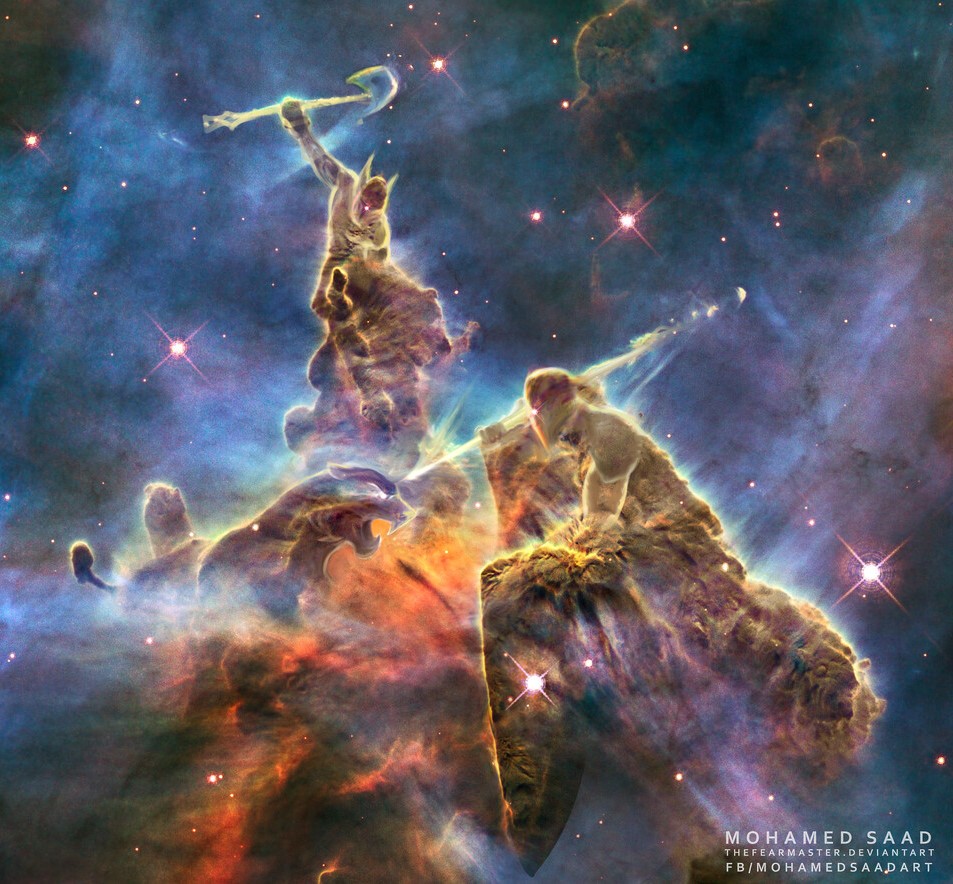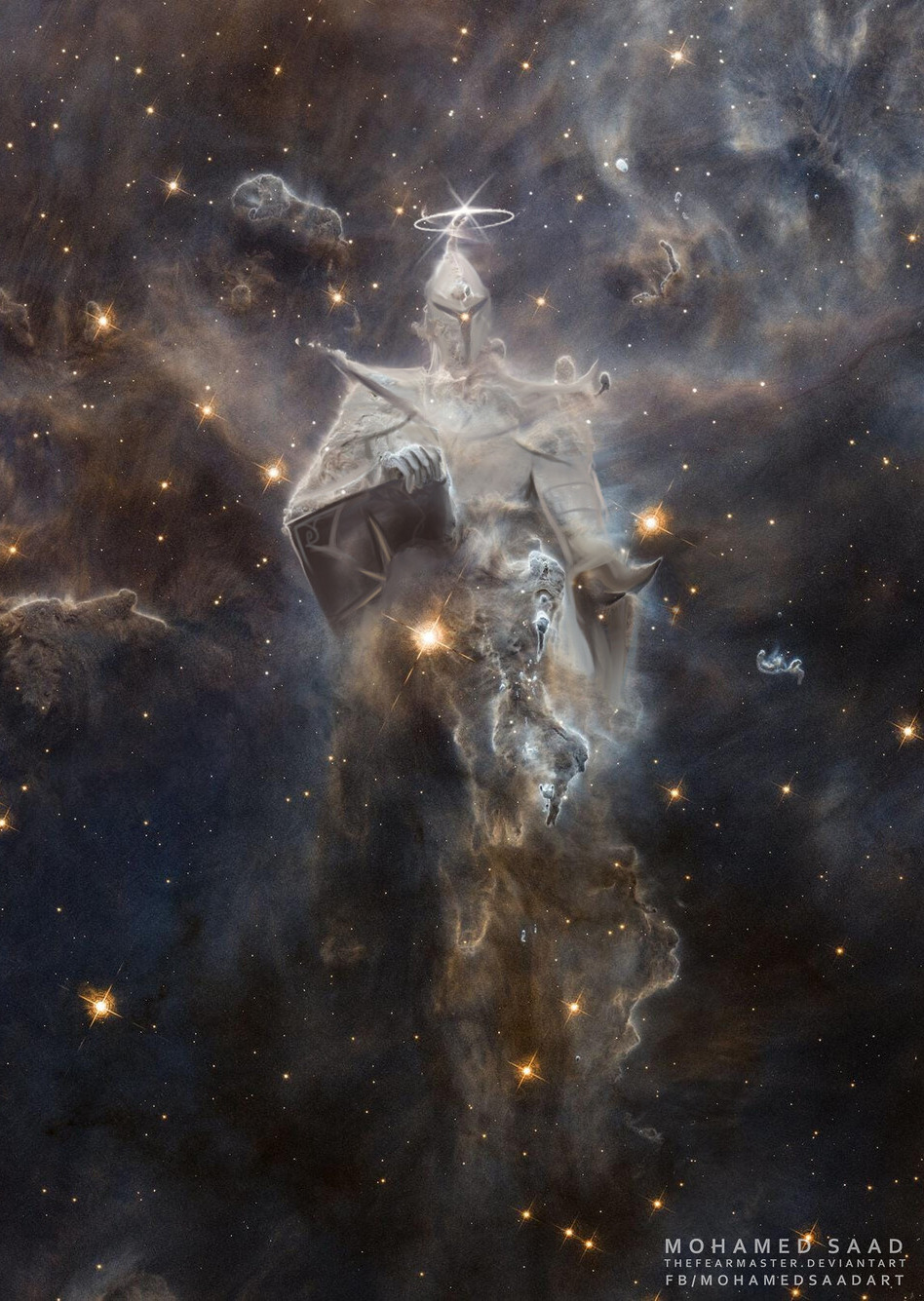Constellations & Cosmic Clouds
The countless myths and legends of The Varolian are impossible for any single mortal to count or recall, and yet the world itself will remember them all, for they are infused into the very bones of the earth. On the land and in the seas are landmarks great and small, constructed by people or by gods to ensure stories can live on. Some of the most impactful or noteworthy tales have the high, yet often tragic, honour, of being woven into the stars themselves.
Many of the known constellations and shaped clouds of cosmic dust are cautionary tales or tragedies, often with a moral that it seems the Gods wish for mortalkind to never forget. Only an extremely rare few are truly ascended to the heavens as a reward, but they serve as inspiration for many to strive towards.
Many more to be added!
The Chase
Also known as "The Paradox", this is actually two entirely separate constellations that appear in two different parts of the night sky; one a fox whose lights are amongst the first to be seen each night, the other a panther that rises past the horizon a few hours afterwards. They have become perhaps the most well known star structures in recent times, for the fact that they simply appeared one night in the year 673, baffling astronomers and astrologers across The Varolian, for such an event has not happened in over a century. Their story is one of destiny, and the dangers of attempting to subvert it. There was once a God-blessed vixen sent to punish a town for insulting The Wanderer and denying his priests Xenia during a pilgrimage, refusing to grant them food or shelter. To aid it on its way, The Divine Herald gave the fox a touch of fate: it could never be caught. The town offered many rewards to rid them of this fleetfooted curse, but neither mage nor hero could catch the creature with magic nor traps. Embellished legends even claim that the fox, with glee and hubris, was tricked into challenging The Shadow to a race, and even outran Death himself! Eventually the town grew desperate enough to seek the aid of an evil witch, one with a history of defying the Gods. With the blood of unholy beasts she was able to imbue a wildcat with a destiny of its own: it could catch whatever it chased. It was sent to end the fox, and chased it up and down the mountain ranges of Teráka, sundering the peaks as they ran. But a paradox had been created - the fox must escape, and yet the cat must have its prize. Every time the cat seemed but the width of a hair from its prey, the entire world shuddered as the fox sped up once again. The earth began to splinter, and the sky began to storm, as the cosmic thread that binds all reality was stretched to breaking point. All hope seemed lost, until the Gods spoke at last. The blessed creatures were flung into The Aether, where they could continue their impossible chase beyond the reaches of mortal space and time for all eternity. The witch who had enchanted the feline was apparently never seen again, and many legends have sprung up concerning how she is likely being punished by the Gods for nearly destroying the world. It has since become a cautionary tale, stating in no uncertain terms that mortals cannot, and should not, ever dream of defying or manipulating The Fates, for their wrath could undo all creation.Arpaktikos - The Chalice
This constellation is one of a celestial goblet, with a hand reaching ever towards it. It is also known as "Euphorion's Folly", for it is an eternal reminder of the ancient King Euphorion of Pelíos, who thought to steal from the Gods and invited ruin upon his legacy. Legend has it that the King was once a ruler most wise and mighty, until his wife and children grew ill with a malady that no mortal magic could heal. He searched desperately across the world for someone, or something, that could help him, and collected many powerful items along the way. None could be used to cure his family, but in his wisdom he used his treasure as offerings to the Gods, pleading to them for aid. Tender-hearted Sédróm felt his heart ache for the mortal, and showed Euphorion a pathway to The Aether, so that he may request from the Pantheon their Ambrosia, the celestial fruit and drink of the very Gods above. The legends of Ambrosia are endless, for it is said to heal the sick, raise the dead, or even grant immortality to those who eat it. Equipped with an offering of power for each of the Gods, he had expected a council of some kind, a place to explain himself and beg for the means to return his loved ones to health. He was surpised to find only Kanzu The Bloody, who issued a challenge - best The Warrior in a duel, and Euphorian would have his Ambrosia. A trick this must surely be, for Euphorion is a man and The Conqueror a God? The battle was short, but not for the reasons one may think. Euphorion, adorned in the many artifacts he had originally prepared to give as gifts, managed to inflict a single wound during a terrible onslaught and watched with amazement as what flowed forth was not blood, but an ethereal liquid so magical and otherworldly that it must be none other than Ambrosia itself! Euphorion collected this most celestial of substances and fled his duel, fled from heaven itself. He traveled home, and his loved ones drank their supposed panacea only to die but seconds after. Sédróm had tried to warn as Euphorian fled the stars; the blood of Gods and Ambrosia are very different things - one bestowing divinity, but the other? Deadly to mortals as few poisons could hope to be. In his grief and rage, Euphorion ruled his home with a cruel and bitter hand, no more than a shadow of the wise ruler he had been before. The people suffered for years until a mighty prince from another land arrived, declaring “You have fled our duel once, you will not do so again.” Kanzu revealed himself in his full glory, slaughtering the king and all who would defend him, ending their tragic lives. Ever a lover of stories and mortals, Sédróm had the tale sent to the stars, a reminder for all to caution desperation with wisdom, and avoid the pitfalls of greed or cowardice.Kratis - The Kraken
This nebula of grasping tendrils is a hidden dust cloud far from the world, barely visible unless one has enhanced eyesight or magical tools. It exists to remind the world of the terrible fate of Eresúri, and the battle that destroyed it centuries ago. The city, once the shining jewel of Ósa, had grown arrogant in its splendour, believing itself so great and mighty that the rest of The Republic was no longer needed. Inspired by the then recent secession of Praelos, the rulers declared their city and all surrounding lands independent, severing themselves and demanding outrageous terms to trade all that was once freely given. Their newfound isolationism would be their doom. Kratis, a kraken so ancient and mighty that it was thought to be the very origins of the species' name, travelled to Eresúri, and brought ruin with it. For months it destroyed every ship sent to or from the city, frightened off every fish and bird, and flooded the land with its movements. Eresúri's once golden lords helplessly watched their people be starved, drowned, and devoured, offering all of their remaining wealth and power to any who could remove this curse. Eventually, after thousands had failed, The Dragon stepped in. The battle left no witnesses. Two of the most powerful creatures the world will ever see clashed for days, the skies and seas for hundreds of miles stormed with each blow struck and, by the end, the foundations of the earth itself would crumble, sinking Eresúri and all its wealth into the sea forevermore. Zarligantír was victorious, but the city and its people were utterly destroyed. Those that know of the constellation state it a warning against hubris, with some even claiming that Kratis was a punishment sent by the Gods in retaliation for the city believing itself greater than the world.The Hydra
A rare example of a constellation with no great tragedy or lesson behind it, it commemorates instead the defeat of The Breaker's greatest champion - a hydra with the blood of a demigod in its veins. In the first days following Kiderha's death during the Archonomachy, Fidain's power ran unchecked across the world. Even after the serpent god was imprisoned, his creations threatened to finish the task the Archons had begun. But great heroes stood against them, with names lost to history, and Fidain's firstborn was slain. With the progenitor of all hydras defeated, the turning point in the war had begun. Eventually the Archons were defeated, Fidain's reach was reduced, and the world could breathe once more. In the many centuries since, it is said that, once every few generations, the spirit of the first hydra possesses one of its kin to rampage across the world yet again. Thankfully such rumours are a myth, and even if they weren't, many heroes yet remain in the world to put an end to the beast no matter how many times it rears its heads.The Gladiators and The Mage
Two of the most complex, yet rarely seen, structures to illuminate the night sky, the scintillating Gladiator Nebula depicts two cosmic warriors battling a lioness, while the pale Mágos Nebula shows a figure in armoured robes and holding a tome of stars. They are not always visible, even with arcane assistance, though the suggested reasons for this, along with what they represent, are many and varied. Some claim that these clouds are usually simply outshone by the stars around them, or that only those who follow similar life-paths can view them reliably. The most popular theory, however, is that these two seemingly separate aetherial nimbi are closely linked, and only unveiled from the darkness when the everlasting conflict between Osa and Praelos reaches a boiling point, such as invasions or great battles. Of course, the last time such a point occured was over a decade ago, and none but the most dedicated astronomers would have been keeping track of such elusive structures while Chyreum burned.Many more to be added!




Comments